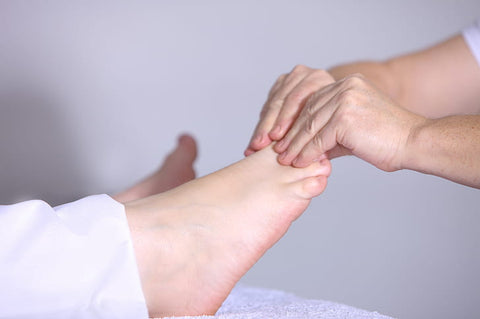Signs of Poor Circulation — and How Boosting Nitric Oxide Can Help
We’ve gathered a few important signs of poor circulation because we know that our health and energy rely on good circulation. After all, your blood carries oxygen and nutrients to every cell in the body—and carries the waste away. You need it!
Ever wonder how that waste is removed from our bodies? The lungs release carbon dioxide when we exhale; the liver detoxifies blood by eliminating toxins through bile and urine; and the kidneys filter out other wastes. What an incredible, miraculous system.
However, when circulation is impaired, a number of health problems and discomforts can result. Recognizing the signs early is key to improving circulation and supporting your overall wellness.
Signs of Poor Circulation
Here are some of the most common indicators your blood flow may be compromised:
Cold Extremities
Cold hands and feet are a prominent indicator of impaired circulation. When blood flow is limited, the body finds it more challenging to keep your limbs warm compared to your core.
Numbness and Tingling
Numbness and a “pins and needles” sensation often appear when blood flow is reduced. Prolonged sitting or standing can make this worse, especially in the feet and hands.
Swelling (Edema)
When blood doesn’t flow properly, fluid can pool in specific parts of the body—especially the feet, ankles, and lower legs. The swelling may worsen throughout the day.
Fatigue
A lack of oxygen and nutrients to tissues and organs can make you feel drained and sluggish. Chronic fatigue can take a serious toll on your day-to-day life and happiness.
Pain and Cramps
Reduced blood flow can cause cramps and pain in muscles, especially during physical activity. Pain in the legs during walking (known as claudication) often signals reduced circulation.
Slow-Healing Wounds
When blood flow is limited, your body struggles to repair cuts, scrapes, or bruises. Inadequate circulation can also raise the risk of infections in severe cases.
Varicose Veins
Twisted, swollen veins (most often in the legs) suggest poor circulation and blood pooling due to damaged vein walls and valves.
Skin Color Changes
Poor circulation may show up as a bluish or purplish hue in the extremities or blotchy/pale skin because not enough oxygen-rich blood is reaching the area.
Digestive Issues / Constipation
When blood supply to the digestive tract is insufficient, nutrient absorption and gut motility may suffer—leading to gas, stomach aches, or constipation.
Hair Loss & Brittle Nails
The health of your hair and nails can be affected by reduced circulation. You may notice thinning hair or brittle, fragile nails.
Why Blood Isn’t Flowing Properly
Here are some root causes of poor circulation and what might be going on behind the scenes:
Plaque & Artery Stiffening (Atherosclerosis)
Fatty deposits can constrict and stiffen arteries, limiting blood flow and leading to circulation problems.
Peripheral Artery Disease (PAD)
This condition affects the arteries in the legs. It’s one of the major causes of impaired circulation, often resulting in pain, cramps, and reduced mobility.
High Blood Sugar / Diabetes
Elevated blood sugar levels damage blood vessels and nerves, which hampers circulation. Diabetic neuropathy can worsen these symptoms.
Excess Weight
Being overweight places extra demand on your circulatory system and increases the risk of diabetes and hypertension—both of which worsen circulation.
Blood Clots
Solidified clots in veins block blood flow. Deep vein thrombosis (DVT) in the legs can lead to dangerous pulmonary embolisms if not addressed.
Raynaud's Disease
This disorder causes small arteries in your limbs to contract excessively under cold or stress, restricting blood flow.
Smoking
Smoking damages blood vessels, reduces arterial flexibility, and worsens circulation in multiple ways.
Sedentary Lifestyle
Too little physical activity slows down blood flow. Regular movement is essential to keep circulation healthy.
How Circulation & Nitric Oxide Are Connected
One of the most important molecules for healthy circulation is nitric oxide (NO). Here’s how it supports blood flow and vascular health:
Nitric oxide acts as a vasodilator—it relaxes and widens your blood vessels, improving circulation and supporting healthy blood pressure.
Reduced nitric oxide levels are associated with arterial stiffness, atherosclerosis, and poor vascular performance.
Dietary nitrates from plants like spinach, beets, and arugula naturally increase nitric oxide production—helping enhance oxygen delivery and stamina.
Because circulation is at the core of delivering nutrients and removing waste, supporting NO production is one of the most effective ways to improve blood flow naturally.
Check out our nitric oxide boosting products here at NutriGardens if you’re looking to support healthy circulation.
Taking Action: What You Can Do
Once you recognize potential signs of poor circulation, here are steps to consider:
1. See your healthcare provider.
If you suspect circulation problems, a doctor can run tests such as cholesterol, blood sugar, and Doppler ultrasounds to identify any underlying issues.
2. Move more.
Exercise stimulates circulation and strengthens your cardiovascular system. Even light activity—like walking or stretching—can help.
3. Eat nitrate-rich foods.
Load your plate with beets, spinach, and arugula. These natural nitrate sources help your body produce more nitric oxide, which supports healthy blood flow.
4. Avoid smoking and manage weight.
These two factors have the most significant negative impact on circulation.
5. Support nitric oxide naturally.
Our clinically standardized nitric oxide boosting products can help restore optimal NO levels to support heart and vascular health. [Insert product link]
In Summary
Slow or restricted circulation can significantly impact your health and quality of life. Recognizing the signs early—cold limbs, numbness, swelling, fatigue, or slow-healing wounds—is the first step. Then it’s about identifying the root causes (like atherosclerosis, diabetes, or inactivity) and taking proactive steps to restore healthy blood flow.
Supporting circulation through lifestyle and diet is essential. Enhancing nitric oxide production is one of the most effective ways to do that—and that’s exactly what our nitric oxide boosting products are designed to help support.
Whenever you notice any symptoms of poor circulation, don’t wait. Addressing it early helps you stay energized, healthy, and thriving.




Comments (0)
There are no comments for this article. Be the first one to leave a message!